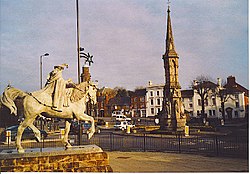Banbury: Difference between revisions
No edit summary |
m Infobox |
||
| Line 1: | Line 1: | ||
{{Infobox town | |||
|name= Banbury | |||
|county = Oxfordshire | |||
|picture=The Fine Lady at Banbury Cross. - geograph.org.uk - 116561.jpg | |||
|picture caption= Banbury Cross | |||
|os grid ref= SP4540 | |||
|latitude= 52.061 | |||
|longitude= -1.336 | |||
|population= 41,802 | |||
|census year= 2001 | |||
|LG district= Cherwell | |||
|constituency= Banbury | |||
|post town= Banbury | |||
|postcode= OX16 | |||
|dialling code= 01295 | |||
|website= [http://www.banbury.gov.uk/ Banbury town council] | |||
}} | |||
'''Banbury''', is the second town of [[Oxfordshire]]. Situated prominently in the north of the county and overspilling into [[Northamptonshire]], Banbury historically was a centre for industry. | '''Banbury''', is the second town of [[Oxfordshire]]. Situated prominently in the north of the county and overspilling into [[Northamptonshire]], Banbury historically was a centre for industry. | ||
The arrival of the Oxford Canal and the railways enabled the already prominent industries to continue. At one time Banbury was known for its plush making, wool and its cattle market, (closed in 1998) which was once the largest in Western Europe. Another once-famous product of Banbury, the Banbury Cake is still in production to a limited scale and resembles an | The arrival of the Oxford Canal and the railways enabled the already prominent industries to continue. At one time Banbury was known for its plush making, wool and its cattle market, (closed in 1998) which was once the largest in Western Europe. Another once-famous product of Banbury, the Banbury Cake is still in production to a limited scale and resembles an Eccles cake. Today, the automotive industry continues in the area, partially influenced by near-by Silverstone, [[Northamptonshire]]. | ||
At the junction of two ancient roads, Salt Way and Banbury Lane, the wool trade flourished in mediaeval times. Banbury Castle was built circa 1135 by Alexander, Bishop of Lincoln, and survived into the Civil War, when it was besieged. Due to its proximity to Oxford, the King's capital, Banbury was a Royalist town, but the inhabitants were known to be strongly Puritan. This led to its use as a base of operations for Oliver Cromwell, who is said to have planned the Battle of Edge Hill in the Globe Room of [http://www.yeoldereindeer.co.uk/ Ye Olde Reindeer Inn] on Parsons Street. Banbury's castle was subsequently demolished after the war by the Parliamentarians. Banbury played an important part in the Civil War. | At the junction of two ancient roads, Salt Way and Banbury Lane, the wool trade flourished in mediaeval times. Banbury Castle was built circa 1135 by Alexander, Bishop of Lincoln, and survived into the Civil War, when it was besieged. Due to its proximity to Oxford, the King's capital, Banbury was a Royalist town, but the inhabitants were known to be strongly Puritan. This led to its use as a base of operations for Oliver Cromwell, who is said to have planned the Battle of Edge Hill in the Globe Room of [http://www.yeoldereindeer.co.uk/ Ye Olde Reindeer Inn] on Parsons Street. Banbury's castle was subsequently demolished after the war by the Parliamentarians. Banbury played an important part in the Civil War. | ||
Revision as of 22:19, 14 November 2010
| Banbury | |
| Oxfordshire | |
|---|---|
 Banbury Cross | |
| Location | |
| Grid reference: | SP4540 |
| Location: | 52°3’40"N, 1°20’10"W |
| Data | |
| Population: | 41,802 (2001) |
| Post town: | Banbury |
| Postcode: | OX16 |
| Dialling code: | 01295 |
| Local Government | |
| Council: | Cherwell |
| Parliamentary constituency: |
Banbury |
| Website: | Banbury town council |
Banbury, is the second town of Oxfordshire. Situated prominently in the north of the county and overspilling into Northamptonshire, Banbury historically was a centre for industry.
The arrival of the Oxford Canal and the railways enabled the already prominent industries to continue. At one time Banbury was known for its plush making, wool and its cattle market, (closed in 1998) which was once the largest in Western Europe. Another once-famous product of Banbury, the Banbury Cake is still in production to a limited scale and resembles an Eccles cake. Today, the automotive industry continues in the area, partially influenced by near-by Silverstone, Northamptonshire.
At the junction of two ancient roads, Salt Way and Banbury Lane, the wool trade flourished in mediaeval times. Banbury Castle was built circa 1135 by Alexander, Bishop of Lincoln, and survived into the Civil War, when it was besieged. Due to its proximity to Oxford, the King's capital, Banbury was a Royalist town, but the inhabitants were known to be strongly Puritan. This led to its use as a base of operations for Oliver Cromwell, who is said to have planned the Battle of Edge Hill in the Globe Room of Ye Olde Reindeer Inn on Parsons Street. Banbury's castle was subsequently demolished after the war by the Parliamentarians. Banbury played an important part in the Civil War.
Today, the M40 and fast rail links, both connecting to Birmingham and London, have enabled Banbury to be used as a vase for many commuters. To some extent, the M40 has also enabled Banbury, which is centrally located within England and regionally, to become a place for smaller businesses to operate from. Some of the more curious traditions which continue in Banbury include the Banbury Street Organ Festival and National Town Criers Competition.

This Oxfordshire article is a stub: help to improve Wikishire by building it up.